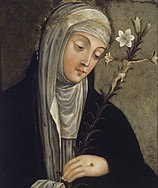Public holidays in Italy
| Part of a series on the |
| Culture of Italy |
|---|
 |
| People |
| Traditions |

Public holidays in Italy are established by the Italian parliament and, with the exception of city or community patronal days, apply nationwide.[2] These include a mix of national, religious and local observances. As for Whit Monday, there is an exception for South Tyrol. In Italy there are also State commemoration days, which are not public holidays.
Overview
[edit]
Italy's National Day, the Festa della Repubblica (Republic Day),[1] is celebrated on 2 June each year, with the main celebration taking place in Rome, and commemorates the birth of the Italian Republic in 1946.[3] The ceremony of the event organized in Rome includes the deposition of a laurel wreath as a tribute to the Italian Unknown Soldier at the Altare della Patria by the President of the Italian Republic and a military parade along Via dei Fori Imperiali in Rome.

Liberation Day is a national holiday in Italy that takes place on 25 April commemorating the victory of the Italian resistance movement against Nazi Germany and the Italian Social Republic, puppet state of the Nazis and rump state of the fascists, in the Italian Civil War, a civil war in Italy fought during World War II. The date was chosen by convention, as it was the day of the year in 1945 when the National Liberation Committee of Upper Italy (CLNAI) officially proclaimed the insurgency in a radio announcement, propounding the seizure of power by the CLNAI and proclaiming the death sentence for all fascist leaders (including Benito Mussolini, who was shot three days later).[4]
17 March was proclaimed a national holiday in 1911, the 50th Anniversary of the Unification of Italy, in 1961, the 100th anniversary of the Unification of Italy, and in 2011, the 150th anniversary of the Unification of Italy. The law no. 222 of 23 November 2012[5] the Giornata dell'Unità nazionale, della Costituzione, dell'inno e della bandiera ("Day of National Unity, the Constitution, the anthem and the flag") was established to be celebrated on 17 March of each year, on the day of the proclamation of the Unification of Italy in 1861, however it is not to be considered a festive day.
Until 1977 the following were also considered public holidays in Italy for civil purposes:[6]
- 19 March, Saint Joseph Day;
- 40 days after Easter, Ascension of Jesus;
- 60 days after Easter, Corpus Christi;
- 29 June, Saints Peter and Paul, patron saints of Rome (it remained a public holiday only in the municipality of Rome);
- 4 November, National Unity and Armed Forces Day.
These public holidays were suppressed, during the austerity caused by the 1973 oil crisis, on the basis of the law n. 54 of 5 March 1977.[6] In particular, in 1977 National Unity and Armed Forces Day became a moveable feast, and celebrations occurred every first Sunday of November.[7] National Unity and Armed Forces Day is an Italian national day since 1919 which commemorates the victory in World War I, a war event considered the completion of the process of unification of Italy. It is celebrated every 4 November, which is the anniversary of the armistice of Villa Giusti becoming effective in 1918 declaring Austria-Hungary's surrender.[7] Italy entered World War I in 1915 with the aim of completing national unity and for this reason, the Italian intervention in World War I is also considered the Fourth Italian War of Independence,[8] in a historiographical perspective that identifies in the latter the conclusion of the unification of Italy, whose military actions began during the revolutions of 1848 with the First Italian War of Independence.[9][10]
In addition to the 12 national holidays, each city or town celebrates a public holiday on the occasion of the festival of the local patron saint. For example, Rome on 29 June (Saints Peter and Paul), Milan on 7 December (Saint Ambrose), Naples on 19 September (Saint Januarius), Venice on 25 April (Saint Mark the Evangelist) and Florence on 24 June (Saint John the Baptist).[2] In South Tyrol, the holiday is instead on Whit Monday. This makes the total public holidays in Italy 13.
The Italian national patronal day, on 4 October, celebrates Saints Francis and Catherine. Notable patronal festivals in Italy are the Festival of Saint Agatha in Catania, the Feast of Saints Peter and Paul in Rome, the Feast of San Gennaro in Naples and Little Italy, New York[11] and the Feast of Our Lady of the Hens in Pagani.
This number does not correspond to the number of days off work as public holidays falling on weekends are not transferred. When a holiday falls on a Tuesday or a Thursday it is common practice to make a ponte (pl. ponti. English: "bridge") in order to have a long weekend. Schools are usually closed.
Christmas in Italy (in Italian: Natale) begins on 8 December, with the feast of the Immaculate Conception, the day on which traditionally the Christmas tree is mounted and ends on 6 January, of the following year with the Epiphany (in Italian: Epifania).[12] The term "Natale" derives from the Latin natalis, which literally means "birth".[13] Easter in Italy (Italian: Pasqua) is one of that country's major holidays.[14] Easter in Italy enters Holy Week with Palm Sunday, Maundy Thursday, Good Friday and Holy Saturday, concluding with Easter Day and Easter Monday. Each day has a special significance.
During the Italian public holidays, peaks of tourist flows in Italy are recorded, particularly in winter due to the Christmas and New Year's Day holidays,[15] in spring, due to the Easter holidays,[16] and in summer, due to the favourable climate.[17] For internal tourism, peaks of tourist flows are also recorded on the occasion of the three national civil holidays, Liberation Day (25 April), International Workers' Day (1 May) and the Festa della Repubblica (2 June),[18][19] as well as for three religious holidays, the Ferragosto (15 August),[20] All Saints' Day (1 November)[21] and the Feast of the Immaculate Conception (8 December), especially in the presence of ponti.[22]
Current holidays
[edit]
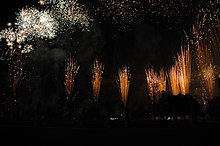

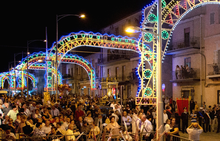
Current holidays in Italy are:[24]
| Date | English Name | Italian Name | Remarks |
|---|---|---|---|
| Every Sunday | In Italy, Sunday is always a public holiday[a] | ||
| Variable[b] | Patronal festival | Festa del santo patrono | Public holiday established by each comune limited to its own territory to celebrate the saint who has the role of patron saint of the municipality |
| 1 January | New Year's Day | Capodanno | |
| 6 January | Epiphany | Epifania | |
| Sunday after the first full moon following the spring equinox[c] | Easter Sunday | Pasqua | |
| Monday after Easter | Easter Monday | Lunedì dell'Angelo, Lunedì in Albis or more commonly Pasquetta | |
| 25 April | Liberation Day | Festa della Liberazione | The day commemorates the victory in 1945 of the Italian resistance movement against Nazi Germany and the Italian Social Republic, puppet state of the Nazis and rump state of the fascists, in the Italian Civil War, a civil war fought in Italy during World War II. |
| 1 May | Labour Day | Festa del Lavoro (or Festa dei Lavoratori) | |
| 2 June | Republic Day | Festa della Repubblica | The day commemorates the institutional referendum held by universal suffrage in 1946, in which the Italian people were called to the polls to decide on the form of government following World War II and the fall of Fascism. The day is one of the national symbols of Italy. |
| 15 August | Assumption Day | Assunzione (Ferragosto) | Ferragosto is a public holiday celebrated on 15 August in all of Italy. It originates from Feriae Augusti ("Festivals [Holidays] of the Emperor Augustus"), the festival of Augustus, who made 1 August a day of rest after weeks of hard work on the agricultural sector. As the festivity was created for political reasons, the Catholic Church decided to move the festivity to 15 August which is the Assumption of Mary allowing them to include this in the festivity. |
| 1 November | All Saints' Day | Tutti i santi (or Ognissanti) | |
| 8 December | Immaculate Conception | Immacolata Concezione (or just Immacolata) | |
| 25 December | Christmas Day | Natale | |
| 26 December | Saint Stephen's Day | Santo Stefano | In Italy, Saint Stephen's Day became a public holiday in 1947, where previously it was a normal working day; the Catholic Church also celebrates it as a religious holiday, even if not as a precept, as it is in Germany and other German-speaking countries. The reason for the public holiday in Italy, not required by the Catholic Church despite the fame of the saint, is to be found in the intention of prolonging the Christmas holiday, creating two consecutive public holidays, which also happens in the case of Easter Monday, a non-religious holiday, but which only wants to lengthen Easter.[25] Before 1947 the two days were working days, with banks and offices open. |
State commemorations
[edit]The following days are not public holidays, but are nevertheless official State commemorations.[1][24]
Civil solemnities
[edit]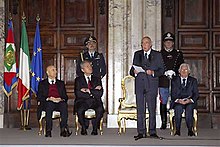
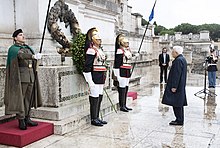
| Date | English Name | Italian Name | Remarks |
|---|---|---|---|
| 10 February | National Memorial Day of the Exiles and Foibe | Giorno del ricordo | Made a national day by law no. 92 of 30 March 2004.[26] It is an Italian celebration for the memory of the victims of the Foibe and the Istrian–Dalmatian exodus, which led to the emigration of hundreds of thousands (between 230,000 to 350,000) of local ethnic Italians (Istrian Italians and Dalmatian Italians) from Yugoslavia after the end of World War II. |
| 11 February | Lateran Treaty Day[1] | Patti Lateranensi | Treaty between the Kingdom of Italy and the Holy See establishing, among others, the recognition of the Vatican City as an independent state. |
| 9 September | Day of Remembrance for Sailors Lost at Sea | Giornata della memoria dei marinai scomparsi in mare | Made a national day by law no. 204 of 14 December 2012.[1] |
| 28 September | Four Days of Naples Day[1] | Insurrezione popolare di Napoli contro i nazifascisti or Quattro giornate di Napoli | It was an uprising in Naples against Nazi German occupation forces from September 27 to 30 September, 1943, immediately prior to the arrival of Allied forces in Naples on 1 October during World War II. |
| 4 October | Saint Francis and Saint Catherine | San Francesco e Santa Caterina | Made a national day by law no. 132 of 4 March 1958.[1] Patron saints of Italy.4/3/1958 n. |
| 4 November | National Unity and Armed Forces Day | Giorno dell'Unità Nazionale e Festa delle Forze Armate | A public holiday from its inception in 1919 till 1977, it commemorates the victory of Italy in World War I, a war event considered the completion of the process of unification of Italy. It is celebrated every 4 November, which is the anniversary of the armistice of Villa Giusti becoming effective in 1918 declaring Austria-Hungary's surrender. |
| 12 November | Remembrance day for military and civilian fallen in international peace missions | Giornata del ricordo dei Caduti militari e civili nelle missioni internazionali per la pace | Made a national day by law no. 162 of 12 November 2009.[1] |
Celebratory days
[edit]
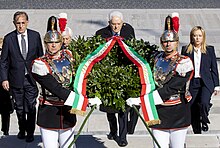
| Date | English Name | Italian Name | Remarks |
|---|---|---|---|
| 7 January | Tricolour Day | Festa del tricolore | Flag day made a national day by law no. 671 of 31 December 1996. The official celebration of the day is held in Reggio Emilia, the city where the Italian tricolour was first adopted as flag by an Italian sovereign state, the Cispadane Republic, on 7 January 1797. |
| 26 January | National day of remembrance and sacrifice of the Alpini | Giornata nazionale della memoria e del sacrificio degli Alpini | Made a national day by law no. 44 of 5 May 2022.[1] |
| 27 January | International Holocaust Remembrance Day | Giorno della Memoria | Made a national day by law no. 211 of 20 July 2000.[27] It is an international memorial day that commemorates the victims of the Holocaust, which resulted in the murder of one third of the Jewish people, along with countless members of other minorities between 1933 and 1945 by Nazi Germany, an attempt to implement their "final solution" to the Jewish question. |
| 1 February | National day of civilian victims of wars and conflicts in the world | Giornata nazionale delle vittime civili delle guerre e dei conflitti nel mondo | Made a national day by law no. 9 of 25 January 2017.[1] |
| 20 February | National day of health, social and social care and voluntary workers | Giornata nazionale del personale sanitario, sociosanitario, socioassistenziale e del volontariato | Made a national day by law no. 155 of 13 November 2020.[1] |
| 21 February | National Braille Day | Giornata nazionale del Braille | Made a national day by law no. 126 of 3 August 2007.[1] |
| 6 March | Day of the Righteous of Humanity | Giornata dei Giusti dell'umanità | Made a national day by law no. 212 of 20 December 2017.[1] |
| 17 March | Anniversary of the Unification of Italy | Anniversario dell'Unità d'Italia | The day celebrates the birth of Italy as a modern nation state, which took place following the proclamation of the Kingdom of Italy on 17 March 1861. However, the complete unification of Italy took place only in the following years. 17 March was proclaimed a national holiday in 1911, the 50th Anniversary of the Unification of Italy, in 1961, the 100th Anniversary of the Unification of Italy, and in 2011, the 150th Anniversary of the Unification of Italy. With the law no. 222 of 23 November 2012[5] the Giornata dell'Unità nazionale, della Costituzione, dell'inno e della bandiera ("Day of National Unity, the Constitution, the anthem and the flag") was established to be celebrated on 17 March of each year, on the day of the proclamation of the Unification of Italy in 1861, however it is not to be considered a day festive. |
| 18 March | National day in memory of the victims of the coronavirus epidemic | Giornata nazionale in memoria delle vittime dell'epidemia di coronavirus | Made a national day by law no. 35 of 18 March 2021.[1] |
| 21 March | National day of memory and commitment in remembrance of the victims of the mafia | Giornata nazionale della memoria e dell'impegno in ricordo delle vittime delle mafie | Made a national day by law no. 20 of 8 March 2017.[1] |
| 22 April | Earth Day | Giornata della Terra | Earth Day is an international annual event on 22 April to demonstrate support for environmental protection. First held on 22 April 1970, it now includes a wide range of events coordinated globally by EarthDay.org (formerly Earth Day Network).[28] including 1 billion people in more than 193 countries.[28][29] |
| 5 May | National day against pedophilia and child pornography | Giornata nazionale contro la pedofilia e la pedopornografia | Made a national day by law no. 41 of 4 May 2009.[1] |
| 9 May | Remembrance day dedicated to victims of terrorism | Giorno della memoria dedicato alle vittime del terrorismo | Made a national day by law no. 56 of 4 May 2007.[1] |
| Europe Day | Giornata dell'Europa | Europe Day is a day celebrating "peace and unity in Europe"[30][31] celebrated on 5 May by the Council of Europe and on 9 May by the European Union. | |
| 14 June | World Blood Donor Day | Giornata mondiale del donatore di sangue | World Blood Donor Day is held on 14 June each year. The event was organised for the first time in 2005, by a joint initiative of the World Health Organization, the International Federation of Red Cross and Red Crescent Societies to raise awareness of the need for safe blood and blood products, and to thank blood donors for their voluntary, life-saving donations of blood. |
| 2 October | Grandparents' Day | Festa nazionale dei nonni | Made a national day by law no. 159 of 31 July 2005.[1] |
| 3 October | National day in memory of the victims of immigration | Giornata nazionale in memoria delle vittime dell'immigrazione | Made a national day by law no. 45 of 21 March 2016.[1] |
| 4 October | World Animal Day | Giornata mondiale degli animali | World Animal Day is an international day of action for animal rights and welfare celebrated annually on 4 October, the feast day of Francis of Assisi, the patron saint of animals. |
| 9 October | National day in memory of the victims of environmental and industrial disasters caused by human negligence | Giornata nazionale in memoria delle vittime dei disastri ambientali e industriali causati dall'incuria dell'uomo | Made a national day by law no. 101 of 4 June 2011.[1] |
| 12 October | Columbus Day | Giornata nazionale di Cristoforo Colombo | In Italy, Columbus Day has been officially celebrated since 2004.[32] The "Lega Navale Italiana" has created a Regata di Colombo as a celebration of the Italian explorer Christopher Columbus (Italian: Cristoforo Colombo) achievement.[33] Italians have celebrated their "Cristoforo Colombo" naming after him many civilian and military ships, like the ocean liner SS Cristoforo Colombo. |
| 24 October | United Nations Day | Giornata delle Nazioni Unite | United Nations Day is an annual commemorative day, reflecting the official creation of the United Nations on 24 October 1945. In 1947, the United Nations General Assembly declared 24 October, the anniversary of the Charter of the United Nations, to "be devoted to making known to the people of the world the aims and achievements of the United Nations and to gaining their support for" its work.[34] |
| National day of entertainment | Giornata nazionale dello spettacolo | Made a national day by law no. 164 of 28 October 2021.[1] | |
| 9 November | Freedom day | Giorno della libertà | Made a national day by law no. 61 of 15 April 2005.[1] |
| 21 November | National Tree Day | Giornata nazionale degli alberi | Made a national day by law no. 10 of 14 January 2013.[1] |
| 25 November | International Day for the Elimination of Violence against Women | Giornata internazionale per l'eliminazione della violenza contro le donne | The United Nations General Assembly has designated November 25 as the International Day for the Elimination of Violence against Women (Resolution 54/134).[35] The premise of the day is to raise awareness around the world that women are subjected to rape, domestic violence and other forms of violence; furthermore, one of the aims of the day is to highlight that the scale and true nature of the issue is often hidden. |
| Third Sunday of November | National day in memory of road victims | Giornata nazionale in memoria delle vittime della strada | Made a national day by law no. 227 of 29 December 2017.[1] |
| 1 December | World AIDS Day | Giornata mondiale contro l'AIDS | World AIDS Day, designated on 1 December every year since 1988,[36] is an international day dedicated to raising awareness of the AIDS pandemic caused by the spread of HIV infection and mourning those who have died of the disease. |
See also
[edit]Notes
[edit]References
[edit]- ^ a b c d e f g h i j k l m n o p q r s t u v w x "Le feste mobili. Feste religiose e feste civili in Italia" (in Italian). Retrieved 29 December 2022.
- ^ a b "Festività nazionali in Italia" (in Italian). Governo Italiano - Dipartimento per il Cerimoniale dello Stato. Retrieved 1 March 2022.
- ^ "Festività nazionali in Italia" (in Italian). Italian Embassy in London. Archived from the original on 24 June 2012. Retrieved 15 April 2012.
- ^ "Fondazione ISEC – cronologia dell'insurrezione a Milano – 25 aprile" (in Italian). Retrieved 28 September 2019.
- ^ a b "LEGGE 23 novembre 2012, n. 222" (in Italian). Retrieved 29 December 2022.
- ^ a b "LEGGE 5 marzo 1977, n. 54" (in Italian). Retrieved 27 December 2022.
- ^ a b "Perché il 4 novembre è festa". Il Post (in Italian). 4 November 2014.
- ^ "Il 1861 e le quattro Guerre per l'Indipendenza (1848–1918)" (in Italian). Retrieved 12 March 2021.
- ^ "La Grande Guerra nei manifesti italiani dell'epoca" (in Italian). Archived from the original on 23 September 2015. Retrieved 12 March 2021.
- ^ Genovesi, Piergiovanni (11 June 2009). Il Manuale di Storia in Italia, di Piergiovanni Genovesi (in Italian). ISBN 9788856818680. Retrieved 12 March 2021.
- ^ "San Gennaro – The Patron Saint of Naples and Little Italy, NYC". Archived from the original on 25 February 2009. Retrieved 4 October 2022.
- ^ "The Best Christmas Traditions in Italy". Walks of Italy. 25 November 2013. Retrieved 26 January 2021.
- ^ "Natale, origine del nome". Etimo Italiano (in Italian). Archived from the original on 8 December 2015. Retrieved 26 January 2021.
- ^ "Easter: How does Italy celebrate this festivity?". Retrieved 6 January 2024.
- ^ "Vacanze di Natale 2021, dove andare: caccia alle destinazioni meno battute" (in Italian). Retrieved 23 April 2022.
- ^ "Pasqua: città d'arte piene di turisti e prove d'estate sulle spiagge" (in Italian). Retrieved 23 April 2022.
- ^ "Stagionalità" (in Italian). Retrieved 23 April 2022.
- ^ "Turismo, Pasqua-25 aprile boom in Italia: ponte ricchissimo da 5,5 miliardi" (in Italian). Retrieved 23 April 2022.
- ^ "Festa del 2 giugno, il turismo riparte: 9 mln di italiani in viaggio" (in Italian). Retrieved 23 April 2022.
- ^ "Turismo, ponte di Ferragosto verso il tutto esaurito anche nella provincia di Viterbo" (in Italian). Retrieved 23 April 2022.
- ^ "Ponte Ognissanti, 10 milioni di italiani in viaggio: meta preferita sono le città d'arte" (in Italian). Retrieved 23 April 2022.
- ^ "8 dicembre: Assoturismo-CST, l'incertezza frena il turismo, per Ponte Immacolata 4 milioni di pernottamenti ma tante camere vuote" (in Italian). Retrieved 23 April 2022.
- ^ "Il Natale accende Verona con le luminarie, alberi, stelle e proiezioni grafiche". Verona Sera (in Italian). Retrieved 26 January 2021.
- ^ a b "Ufficio del Cerimoniale di Stato" (in Italian). Retrieved 29 December 2022.
- ^ "Santo Stefano: perché si festeggia il 26 dicembre?" (in Italian). Retrieved 28 December 2022.
- ^ "Legge n. 92 del 30 marzo 2004" (in Italian). Retrieved 30 December 2022.
- ^ "L. 20 luglio 2000, n. 211 (1) Istituzione del "Giorno della Memoria" in ricordo dello sterminio e delle persecuzioni del popolo ebraico e dei deportati militari e politici italiani nei campi nazisti" (PDF). MELA (in Italian). 30 July 2000. Retrieved 3 January 2020.
- ^ a b "EARTH DAY 2020: WHAT IS IT AND HOW DO PEOPLE MARK IT AROUND THE WORLD?". independent.co.uk. 21 April 2020. Retrieved 19 February 2021.
- ^ "The 50th Anniversary Of Earth Day Unites Tens Of Millions Of People Across The World In Action And A Multi-Platform Event". yahoo.com. 24 April 2020. Archived from the original on 22 April 2021. Retrieved 19 February 2021.
- ^ "Europe Day". European Union. 16 June 2016. Archived from the original on 1 July 2019. Retrieved 8 May 2020.
- ^ "Día de Europa: ¿Cuándo y por qué se celebra?" [Europe Day: When and why is it celebrated?]. okdiario.com (in Spanish). 5 June 2018. Retrieved 8 May 2020.
- ^ "Governo Italiano – Dipartimento per il Cerimoniale dello Stato". Governo.it. November 23, 2012. Archived from the original on May 22, 2013. Retrieved January 30, 2015.
- ^ "Regata della "Giornata Nazionale di Cristoforo Colombo"". Lega Navale Italiana. Archived from the original on April 14, 2015.
- ^ United Nations General Assembly Session 2 Resolution 168. United Nations Day A/RES/168(II) 31 October 1947.
- ^ "International Day for the Elimination of Violence against Women". United Nations. 2013. Retrieved 21 March 2013.
- ^ "About World Aids Day". worldaidsday.org. National Aids Trust. Archived from the original on 20 November 2015. Retrieved 4 December 2014.


